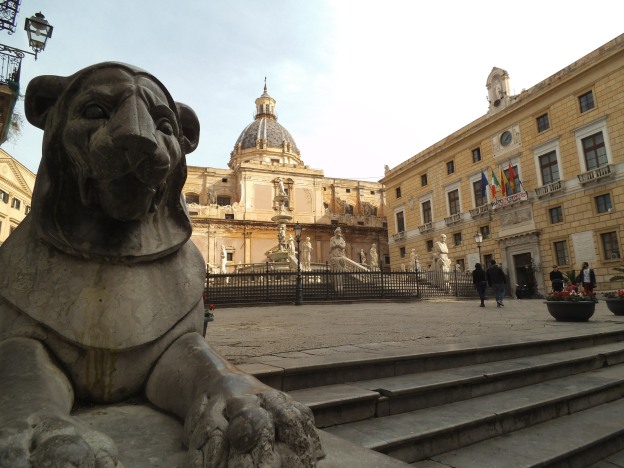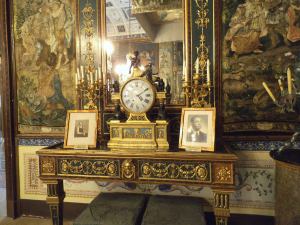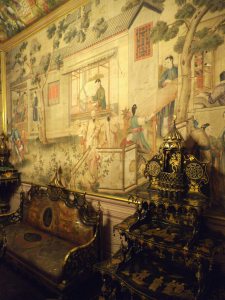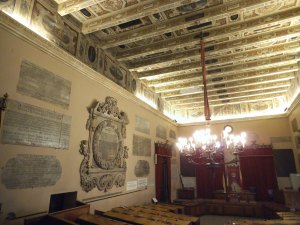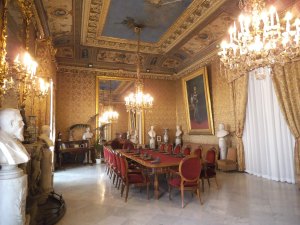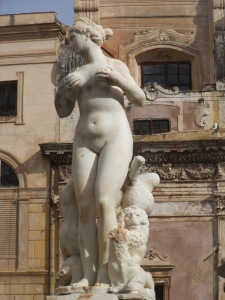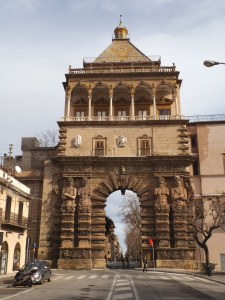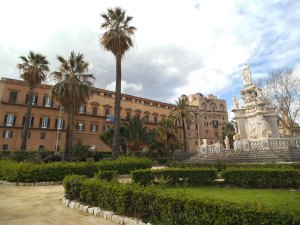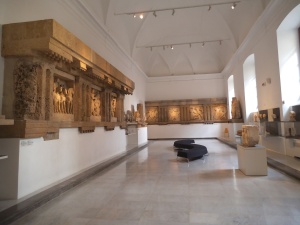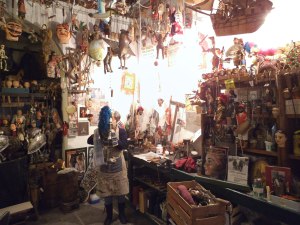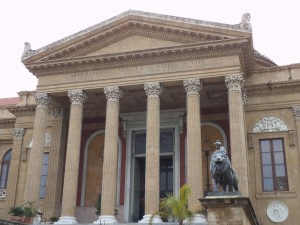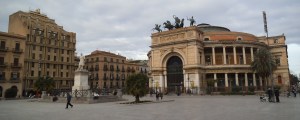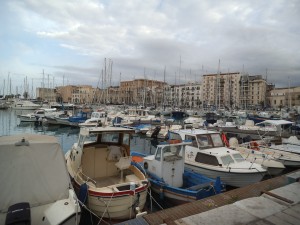 Arriving in Palermo after 24 hours of continuous rain does have its advantages as I don’t have to play dog shit hopscotch as many other visitors have done in the past. Although incredibly busy, the streets are remarkably clean. With a population of 700,000, not including the many illegal immigrants living here, it’s hard to imagine what the city would have been like 2500 years ago when it was a small Phoenician colony.
Arriving in Palermo after 24 hours of continuous rain does have its advantages as I don’t have to play dog shit hopscotch as many other visitors have done in the past. Although incredibly busy, the streets are remarkably clean. With a population of 700,000, not including the many illegal immigrants living here, it’s hard to imagine what the city would have been like 2500 years ago when it was a small Phoenician colony.
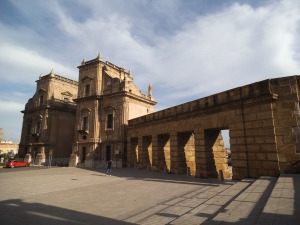 I start my tour of historical Palermo at the 16th century Porta Felice, the main gate next to the quaint, old harbour of La Cala. Although the area was badly damaged by WWII bombing, some ancient buildings survived, including the fortress-like, 14th century Palazzo Chiaramonte, which housed the inquisition between 1685 and 1782. The walls still feature graffiti of the former prisoners and it is a popular tourist attraction managed by students of the university which is now located in the building. It overlooks the jungle-like Giardino Garibaldi where some very old and very large fig trees still reside.
I start my tour of historical Palermo at the 16th century Porta Felice, the main gate next to the quaint, old harbour of La Cala. Although the area was badly damaged by WWII bombing, some ancient buildings survived, including the fortress-like, 14th century Palazzo Chiaramonte, which housed the inquisition between 1685 and 1782. The walls still feature graffiti of the former prisoners and it is a popular tourist attraction managed by students of the university which is now located in the building. It overlooks the jungle-like Giardino Garibaldi where some very old and very large fig trees still reside.
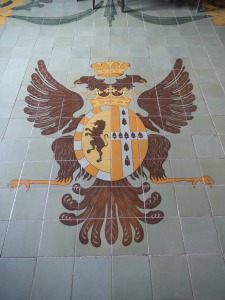 Down a side alley, I locate the 18th century Palazzo Mirto which boasts original décor and furnishings. A visit is like stepping back in time, with carriages stored in the stables, collections of china and artwork, black & white family photos and even a secret passage hidden behind a Greek marble statue. The Filangeri family lived here until 1982 when the house was donated to the Region of Sicily.
Down a side alley, I locate the 18th century Palazzo Mirto which boasts original décor and furnishings. A visit is like stepping back in time, with carriages stored in the stables, collections of china and artwork, black & white family photos and even a secret passage hidden behind a Greek marble statue. The Filangeri family lived here until 1982 when the house was donated to the Region of Sicily.

 My favourite places to visit are often the ones not mentioned in the guide books and it is only thanks to the lovely lady in the Tourist Office that I dare to enter the Municipo (Town Hall). With half a dozen intimidating police officers stood in the doorway it’s easy to assume that there is no public access but I am welcomed inside and directed up a large marble staircase to the council chambers where I’m allowed to roam around at will. Some of the rooms are quite sumptuous, filled with statues and busts of famous Palermitani and a collection of golden guns presented to Palermo by Napoleon.
My favourite places to visit are often the ones not mentioned in the guide books and it is only thanks to the lovely lady in the Tourist Office that I dare to enter the Municipo (Town Hall). With half a dozen intimidating police officers stood in the doorway it’s easy to assume that there is no public access but I am welcomed inside and directed up a large marble staircase to the council chambers where I’m allowed to roam around at will. Some of the rooms are quite sumptuous, filled with statues and busts of famous Palermitani and a collection of golden guns presented to Palermo by Napoleon.
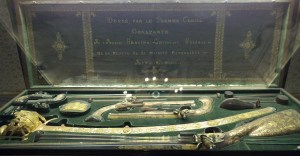
 Outside in Piazza Pretoria is the beautiful 16th century Florentine fountain, so called because it was originally designed for a villa in Florence. Its alternative name is the ‘Fountain of Shame’ due to the presence of naked female figures fondling their breasts. The lower part of the fountain is surrounded with all manner of beasts spouting water.
Outside in Piazza Pretoria is the beautiful 16th century Florentine fountain, so called because it was originally designed for a villa in Florence. Its alternative name is the ‘Fountain of Shame’ due to the presence of naked female figures fondling their breasts. The lower part of the fountain is surrounded with all manner of beasts spouting water.
Beyond the 12th century Cathedral, next to the impressive 14th century Porta Nuova, is the massive Palazzo dei Normanni. Built by the Saracens in the 9th century, it is one of the oldest surviving structures in the city. The Normans enlarged it and the Spanish expanded it further resulting in hundreds of rooms, many of which are used by the Sicilian Parliament. Sadly, the Royal Apartments are closed when I try to visit and the main exhibition happens to be ‘Treasures of the Sicilian Seas’ which I have already seen at the Ashmolean Museum in Oxford.
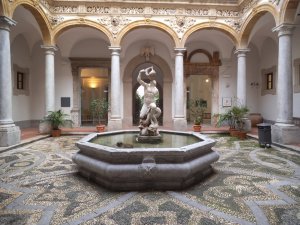 Instead, I move on to the Salinas Archaeological Museum, named for its most important Director of Antiquities. It is currently being refurbished and only the ground floor is open to visitors. However, because of this it is free. I mainly want to see the metopes from Selinunte and fortunately they are on display in one of the ground floor rooms. I’m interested to discover that many of the founding pieces of the museum once belonged to the English Consul Robert Fagan who funded many archaeological digs on Sicily and amassed a large collection of artefacts. When he committed suicide in 1816, due to concerns over huge debts, the Sicilian government took possession of his collection before his widow could sell them off.
Instead, I move on to the Salinas Archaeological Museum, named for its most important Director of Antiquities. It is currently being refurbished and only the ground floor is open to visitors. However, because of this it is free. I mainly want to see the metopes from Selinunte and fortunately they are on display in one of the ground floor rooms. I’m interested to discover that many of the founding pieces of the museum once belonged to the English Consul Robert Fagan who funded many archaeological digs on Sicily and amassed a large collection of artefacts. When he committed suicide in 1816, due to concerns over huge debts, the Sicilian government took possession of his collection before his widow could sell them off.
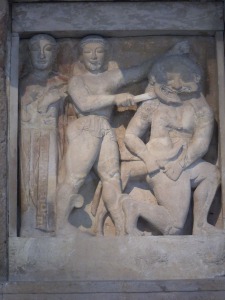
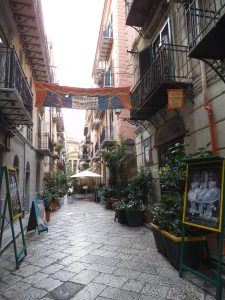 The narrow backstreet between the Museum and the Massimo is lined with puppet theatres and I’m lucky to find someone cleaning the puppets in preparation for a weekend show. Palermo has a long history of puppet theatre. Pupi, the large Sicilian rod puppets, date from the 1600s and traditional stories enacted often tell of the adventures of Charlemagne. However, other famous Italians are also featured, such as Garibaldi and King Vittorio Emanuele.
The narrow backstreet between the Museum and the Massimo is lined with puppet theatres and I’m lucky to find someone cleaning the puppets in preparation for a weekend show. Palermo has a long history of puppet theatre. Pupi, the large Sicilian rod puppets, date from the 1600s and traditional stories enacted often tell of the adventures of Charlemagne. However, other famous Italians are also featured, such as Garibaldi and King Vittorio Emanuele.
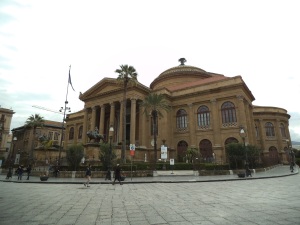 The 19th century Massimo Theatre is the largest opera house in Italy with an impressive neoclassical design. The façade was influenced by the temples of Agrigento and Selinunte and the entrance is guarded by two lions. Inside are five rows of boxes and an opulent gallery with a beautiful ceiling fresco, but I don’t see them as, although it’s possible to have a guided tour inside the theatre, at €8 per person for 30 mins I decide to save my money for other things.
The 19th century Massimo Theatre is the largest opera house in Italy with an impressive neoclassical design. The façade was influenced by the temples of Agrigento and Selinunte and the entrance is guarded by two lions. Inside are five rows of boxes and an opulent gallery with a beautiful ceiling fresco, but I don’t see them as, although it’s possible to have a guided tour inside the theatre, at €8 per person for 30 mins I decide to save my money for other things.
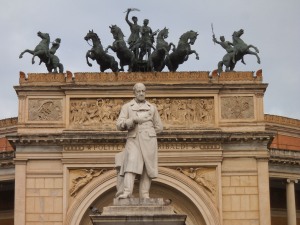 Just down the road is another theatre, the 19th century Politeama Garibaldi. It’s not as beautiful as the Massimo but the bronze chariot and horses above the entrance reminds me of St Mark’s Basilica in Venice. However, instead of pigeons, the pedestrianised square in front of the theatre is populated by skateboarders and homeless men.
Just down the road is another theatre, the 19th century Politeama Garibaldi. It’s not as beautiful as the Massimo but the bronze chariot and horses above the entrance reminds me of St Mark’s Basilica in Venice. However, instead of pigeons, the pedestrianised square in front of the theatre is populated by skateboarders and homeless men.

